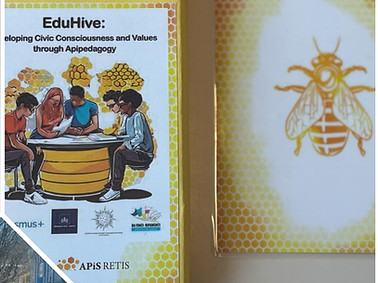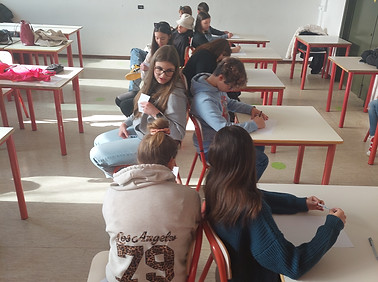EduHive: Developing Civic Awareness and Values through Apipedagogy
EduHive: Developing Civic Awareness and Values through Apipedagogy

Examples of EduHive Apipedagogical School Activities
The purpose of the project EduHive through Apipedagogy is to transfer good practices and at the same time develop new pedagogical activities within the innovative Apipedagogy program, designed for enriched classroom lessons. The project intertwines natural science, social studies, and civic education, encouraging active learning through the analogy between bee democracy and constitutional democracy.
The program is implemented with the support of the manual Bee Democracy and Constitutional Democracy (Nina Ilič), which provides teachers with structured guidelines, and with the help of ten learning cards called Bee Lessons. These cards engage students interactively and creatively, guiding them through topics such as cooperation, community, responsibility, sustainability, and the importance of democratic values.
The project aims to bring students closer to essential values such as solidarity, respect for diversity, and the importance of collective decision-making, while using the metaphor of the beehive as an inspiring example for a democratic society. In doing so, it promotes not only knowledge but also the development of social and civic competencies, critical thinking, and active participation.
.
The overall goal of the project is to create a bridge between nature and society, between experiential learning and civic education – thus contributing to the formation of responsible, tolerant, and engaged young individuals.

Example:
1. Bee colony takes care of queen.
That is affection in the bee colony.
2. A student feels included in the classroom.
That is belonging in the classroom.
Bee Lesson no. 1
Activity: Recognizing the differences between affection and affiliation
Authors: Lara Pikl & Kaja Amon (Slovenia)
Instruction:
Firstly, you split in to 2 groups of 5 people. You have a bag from which you blindly choose a paper. On the paper you will have an example of affection or belonging in the bee colony or the classroom. The whole group will have to participate in the activity so they can correctly present the task they got. The other group will have to guess if it’s belonging or affection. The team who guesses more right wins.
Bee Lesson no. 2
Activity: Clash of the Hives
Authors of the game: Neža Malovšek & Lara Šket (Slovenia)
No. of players: 30 (6 groups of 5 people)
Gameplay: The game Clash of Hives is related to the bee world and improving relationships and preventing violence.
-First, we divide into 6 groups of 5 people.
-Each group gets its own color,
-There is a large hexagon on the floor, and in each corner there is a color,
-One rolls a dice and the number you get determines the topic of your question, the difficulty and how many hexagons you get.
-the questions are divided into two topics (the bee world and peer violence), 3 different difficulties (1-the easiest, 2-medium difficulty and 3-the hardest),
-if you answer the answer correctly you will get the smallest hexagon with which you will build your hive
-if you throw a question on difficulty 1, it is a question on the bee world and if you answer correctly you get 1 hexagon, but if you throw two, it is a question on the topic of peer violence and if you answer correctly you get two hexagons. This continues on all difficulties, only the number of hexagons you get if you answer correctly increases.
-the team that first collects 30 hexagons and makes the most beautiful hive wins :)


Bee Lesson no. 3
Activity: Golden Bee
Authors: Živa Žujič & Alekseja Nedeljković (Slovenia)
Didactic game, for 2 - 8 players, contains 33 cards (16 pairs and Golden Bee). The rules are based on the popular children's card game Black Peter, which was created in Germany.
By drawing cards, players collect pairs. The player who is left with the Golden Bee card loses the game. Through fun and socializing, players gain knowledge about the bee colony.
They discover how bees defend themselves while nurturing their colony and promoting their well-being
Players can relate this information to the relationships and activities within their "school family"—their classroom community.
The purpose of the game is to identify the differences and similarities between the two »families«.
We can divide the class into several groups. Each group plays with its own set of cards. When all groups have finished the game, we can, with the help of additional question cards, make a group evaluation of the acquired knowledge.
Game instructions:
Shuffle the cards and deal them equally among the players. If players find two matching cards, they put them in a pile in front of them. The game continues with the player who has the highest number of cards. The player on his left draws one of his cards. If he has a pair, he puts it on the pile. And so on. The game is played clockwise and ends when one player is left with only the Golden Bee card.
Bee Lesson no. 4
Activity: Drawing
Authors: Naja Griber & Hana Simonič (Slovenia)
Workshop:
Students are divided into pairs. They are sitting together facing our backs. One person in the pair describes a picture they are holding – first by using the task description, and then by describing the visual details. The pictures show different types of bees in a hive. The other student in the pair has to draw the picture based on the instructions they hear. They have 5 minutes, and the pair whose drawing is closest to the original picture wins.WHAT DO YOU NEED:-Bee pictures -Paper and pen-Descriptions

Descriptions;
PHOTO 1:
-Home constructions-Participating in accepting decisions
-(builder)
PHOTO 2:
-Fertilizes the queen and takes care of the brood (hive colding in summer)
-With his presence he creates a plasant climate in the hive
-(drone)
PHOTO 3:
-She is responsible fort he abundance of the bee colony and for the sence of belonging čand connection
-(queen bee)
PHOTO 4:
-The most expirienced (knowledge means security for sustainability)
-Participates in decision – making
-Brings food
-(food forages)
PHOTO 5:
-They are the youngest (immediately after the birth)
-Participating in accepting decisions
-(cleaner)
PHOTO 6:-Decision making involves young bees-Producing food fort he queen, drone and young bees-Working for sustainability and community development-(nursing mother)
PHOTO 7:-They are crucial fot the safety and protection of the colony -They are stationed at the hive entrance, where they control who enters and exits-(guard bees9)

Bee Lesson no. 5
Activity: Preapare winter stores for the bees
Authors: Ume Habiba & Tharusha Kahaduwa
Game Instructions:
Four groups of three students will be formed. Each group will decide which foods are best suited to create a winter supply, creating a list of up to 5 foods. The groups will join together and create a single list of three foods to be stockpiled. At the end of the game, two members of the group will present their choice of food and explain why they chose it.
Bee Lesson no. 6
Activity: Human Board Game
Authors: all participants from Slovenia & Italy
Instructions:
The game is meant for adults and children. People will divide into 4 groups of 3 people. Each group will have its own color and each one of the groups will be one bee (worker bee, queen bee, trot). Each group will also have its own movements and its own strength. You will have cube whit colors instead of numbers, which you will throw and see what color your group gets. Then you will have another cube with numbers. You will throw the cube and move for certain number of places. But you will move with your strength only (special move). The group who gets first to the end wins.


Bee Lesson no. 7
Activity: Adjust your reactivity according to the environment where you are currently located
Authors: Gioele Cassina & Tharusha Kahaduwa
Game Instructions
We are left at Porta Torre (in the city center of Como) and divide into 3 groups of 4. We need to reach Villa Olmo, where we will take the final photo together after completing the following missions: Identify the following places/objects and take a creative photo:
GROUP 1:
-
Medieval house
-
Frog of the Duomo
-
Statue of Alessandro Volta
-
Swan/duck
GROUP 2:
-
Gattoni Tower
-
Voltiano Temple
-
Life Electric
-
Gardens at the lake
GROUP 3
:
-
Piazza San Fedele
-
Social Theater
-
Monument of the fallen
-
Lakeside Viale Geno
Bee Lesson no. 7
Activity: Ekrams apitherapy adventure
Authors: Nina Ilič, Eneja Ilič, Miran Kumer & Nika Drev
Game Instructions
Attention!
The experience that awaits you is not just an ordinary journey. It is a journey in time and space, which transcends all the laws of nature and existence that you know. Right here, in the place where you hold the bee key in your hand, a door opens through which you will enter unknown worlds. And it is not just an ordinary key - it is an artifact [An artifact is an object, usually of cultural, historical significance, created by man in a prehistoric or historical period], full of mystery and power, imbued with the energy of millennia and wisdom.
The bee key is not just an object. It is a gateway that gives you access to unlimited possibilities, immense adventures and journeys through all spatial dimensions and time spheres. Your step into the unknown is decisive, because it depends on you where you will go next. Every decision you make will shape your path, and it depends on you whether you choose the right direction.
When the bee key lights up in your hand, you know that everything is about to change. The world around you begins to give way and a mysterious energy rises from under the ground, inviting you to a journey. Your task is clear: make a decision to take the next step, but do not forget that you must make the decision together with others who will walk alongside you. Taking risks alone is not enough, cooperation, trust and synergy will be required. Just like bees in a hive, where connecting with others ensures success, here, in this mysterious world, you must be part of a community that will solve puzzles and comb unknown landscapes together.
The bee key opens all the doors of this world. And these doors are the ones that lead to the past, the future, to worlds that you have already seen, but have never experienced. You will witness historical events, walk through the dusty paths of ancient civilizations, or discover futuristic landscapes that your eyes have never seen before. Every new light, every new air, every new sound will take you and your companions deeper into a mysterious world where there are no limits to imagination.
When you turn the bee key, when you cross the threshold of this path, you will step onto the edge of the unknown, full of danger and opportunity. So, use it and begin an adventure that will lead you to worlds whose names have not yet been spoken. On this journey, you will not only explore new worlds, but you will also discover your own strength, wisdom and ability to survive in the unknown.
Get ready. It is time to decide. Which world do you want to explore next? Where will you take your steps? Touch the bee key, adventure awaits...
Bee Lesson no. 8
Activity:
Author: Ema Kuralt (Slovenia)
Game instructions:
First you split into groups of 3. There will be 5 questions and every group will have 2-3 minutes to discuss about the answer. After discussing for 2-3 minutes I will ring the bell and everyone will stop. Then every group will tell me their answer and I will decide whose answer is the closest to the right answer. The groups can also cooperate together and make a better answer.
QUESTIONS:
-
The bee colony does not recognize the right to life. In the autumn bees expel all that are not absolutely necessary (drones for example). What about in our class? How do we recognize this right and how do we respect it?
-
In the class we all have the right to our own opinion. But some people are louder and more communicative than other. So opinions of quiet people are sometimes overheard. What about worker bees? Do they have the right to express their own opinion? Yes, they have a right. They communicate until they come to common goal/decision.
-
In the bee hive all the bees have free will (right to move freely). Bees only restrict movement if one of them doesn’t bring anything to the hive. They don’t let that bee into the hive. How do your classmates recognize free movement? With what and in what way? Did anybody ever restrict your free movement?
-
Bees are all equal in front of the law and they always look to the common good. They have one and only law: family survival- that means that every useless member is unwanted. Is it like that in a strong class community?
-
In the class community I feel safe, when for example one of my classmates lends me a pen or gives me their homework to copy, or when a friend is happy to see me. How is it with bees?


Bee Lesson no. 9
Activity: Mission to the perfect hive
Authors: Ume Habiba & Gioele Cassina
Game instructions:
divide the students into 4 groups of 3 bees each (12 bees total).
-
Each group chooses a real (region,contry,nature park) or imaginary location where they want to build the new hive.
-
Groups research (online,books,maps,prior knowledge) the characteristics of their choosen place.
-
Groups prepare a persuasive speech (2-3 minutes) that includes:
-
Type of vegetation
-
Climate
-
Landscape
-
Tourist attractions
-
Each group presents their speech to the other students.
-
After all presentatations, each bee votes (cannot vote for their own group) for the location they believe is the best place to build the new hive.
-
The location that receives the most votes becomes the New Home of the Bees
What is need or to be prepared:
-
Internet access or research materials (books,maps,atlases)
-
Paper ran pen / computer to write the speech
-
Presentation time (2-3 minutes per group)
-
Voting cards or a simple voting method (show of hands)
-
Total time: about 30-45 minutes (research+preparation+presentation+voting)
Bee Lesson no. 10
Activity: Receipe Contest
Authors: Zeno Finzi, Nicolas Cairoli
BEE LESSON NO. 10 – tvoja hrana zdravilo naj bo hrana in tvoje zdravilo naj bo hrana/ lascia che il tuo cibo sia la tua medicina e che la medicina sia il tuo cibo/ let food be thy medicine and medicine be thy food .
NAPKIN GAME
Author: Zeno Dussi Finzi, Nicolas Cairoli.
Make 2 groups of students, one teacher places around 10 meters along from the students and holds a napkin or a flag. The teacher says one of the traditional dishes, for example: jota, potica, lasagne, ričet, parmigiana, prekmurska gibanica… and one person from each group, that knows the recipe for the dish runs and grabs the flag/napkin and tells the recipe. If the person who is answering doesnt know the answer, the other one can say it. The group that first reaches 10 points wins.
A healthy diet makes bees strong and resistant to external attacks, because every being is what it eats. A balanced diet is the basis of health for humans too, who, however, prefer to rely on their desires for the moment.

